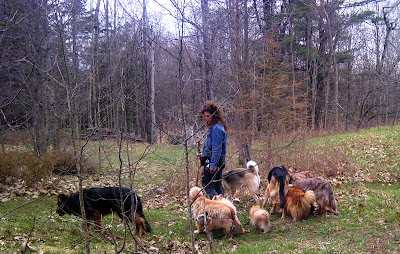Fatty Tumors (Lipomas) in Dogs - Benign (Fatty) or Malignant (Mast Cell) – Cause, DIY Holistic Treatments, Remedies
In this Article:
- What, How, When and Why Fatty Tumors (Fatty Lipomas) Occur
- What is a Fatty Lipoma, How and Why They Occur
- Characteristics of a Fatty Lipoma
- Fatty Lipomas Are a Warning Sign
- How to Assess Your Dog's Toxic Exposure
- Why Conventional Treatments Don't Work
- A Dysfunctional Approach
- Bad Advice
- Ineffective Conventional Treatments
- The Truth About Fatty Lipomas
- A Natural Approach to Treating Fatty Lipomas
- Diet Matters - How to Assess Your Dog's Current Diet
- These Simple Statistics Don't Lie
- What To Do If You're Currently Feeding Your Dog an Inappropriate Diet
- Supplemental Foods and Herbs
- Reduce Toxic Exposures - Natural Insect Parasite Treatments
- Natural Topical Treatment for Fatty Lipomas
- Signs Of a Malignant Cell Growth
1.0 What, How, When and Why Fatty Tumors (Fatty Lipomas) Occur
1.1 What
is a Fatty Lipoma, How and Why They Occur
A
fatty tumor is a soft mass under the skin.
Your dog's body eliminates toxins via their intestines, kidney and liver, this is the body's natural process. However, when the natural system becomes overloaded, the body is not able to perform as it would normally. When a dog is constantly ingesting toxins the
kidney and liver are forced to work overtime to clear out unwanted
substances from the body. If the toxic load becomes too much for the kidneys and
liver to process, toxins cannot be eliminated. The constant presence of
contaminates in the body also creates stress on the endocrine (glands which secret
various hormones to regulate metabolism, sleep, mood, etc.) and immune system.
The body ‘captures’ the toxins and shifts them as far as possible from vital organs. The furthest place from vital organs is the skin. Your dog's skin is the largest excretory organ in their body. The lymph system carries the toxins to the skin where they are stored in fat deposits just under the surface of
the skin. This creates the fatty lipoma (fatty tumor).
1.2 Characteristics
of a Fatty Lipoma
A
soft mass under the skin that:
- Does not cause *hair loss.
- Does not cause *pain.
- Does not cause *redness or *irritation of the skin on its own.
- Is freely movable under the skin;
- When the mass is located on the body of your dog, and;
- The mass has increased in size, and;
- As a result, is rubbing against your dog’s leg;
- The mass may then cause hair loss or irritation as it rubs against your dog’s leg.
1.3 Fatty Lipomas Are a Warning Sign
Fatty
deposits are a warning sign, a red flag that tells you your dog's:
- Body is under siege from constant exposure to toxins.
- Internal system is out of balance and is not able to eliminate enough toxic waste.
- Immune system is weak and requires care to improve it's strength.
A species appropriate diet, a natural personal care routine, and exercise are foundational to your companion animal's good health.
A weak immune system leaves the body vulnerable to illness, infection and health issues.
1.4 How to Assess Your Dog's Toxic Exposure
There are multiple ways your dog can end up exposed to toxins. For example toxins can enter the body through the oral cavity, nasal passage and skin. Examples of how these exposure occur are provided just below.
1.4.1 Ingested Toxins
Ingredients
in dry food (kibble, biscuits), wet (canned) food, highly processed treats, freeze dried food, dehydrated and air dried food products, and poor quality raw food products. For example:
- Refined cereal grains.
- Food flavoring.
- Starchy carbohydrates.
- Synthetic chemical preservatives e.g. ethoxyquin and TBHQ.
- Synthetic minerals and other food additives.
- Sugar.
- Pesticide, herbicide and fungicide residue in corn, soy, canola, safflower, cottonseed oil, hydrolyzed vegetable protein, sugar beets, etc.
1.4.2 Food Products and Components
An inappropriate diet is a major contributing factor in the development of fatty lipomas:
- All dry, canned, wet food diets and treats.
- Freeze dried, dehydrated and air dried diets.
- Raw diets that contain inappropriate foods and food additives.
- Cooked diets that contain inappropriate foods and food additives.
Examples of problematic ingredients in food and treats include:
- Intensively farmed animals, learn more here.
- Concentrated animal feeding operations, learn more here.
- Condemned, denatured meat, bone, fat and other animal derivatives, learn more in here.
- Other hidden and 'incidental' substances.
1.4.3 Conventional Personal Care Products
Conventional personal care products are a major source of toxins, for example, conventional flea, tick, intestinal parasite and heartworm products.
To reduce your dog's exposure, choose natural alternatives for worming, and for dealing with ticks, fleas and mosquitoes. Examples of natural alternatives are provided further below.
1.4.4 Additional Daily Toxic Exposures
- Dental chews.
- Toothpaste.
- Shampoo.
- Household cleaners.
- Fluoridated water, water high in hard metal content.
- Pesticides, fertilizers, herbicides, from grass, road salt, etc. absorbed through the skin of the paws, ingested by licking fur and paws.
How
many of the toxins listed above is your dog regularly exposed to?
Do a quick
analysis and then read on.
2.0 Why Conventional Treatments Don't Work
2.1 A Dysfunctional Approach, Lack of Knowledge
Conventional
practitioners of medicine (human and veterinary care) are oriented towards
treating an acquired condition rather than treating the body as a whole
entity. As such they do not understand the root cause, nor the significance of the condition.
2.2 Bad Advice
As a result, when a conventional veterinarian sees a fatty tumor the typical advice provided is:
2.3 Ineffective Conventional Treatments
If
the fatty tumor is in the way of proper function the following options may be
offered;
- Surgical removal.
- Liposuction.
- Conventional topical salve.
- Steroid
injections.
The
fundamental problem with conventional interventions is that they don't address the root cause of the condition. If the root cause is not addressed, fatty lipomas (fatty tumors):
- Persist, grow and in many cases, additional lipomas occur.
- In many cases when the fatty lipoma is removed, it regrows.
- Eventually malignant mast cell growth may occur.
Many practitioners of conventional veterinary medicine will tell you that there is nothing that you can do to:
- Reduce the size of the existing fatty tumor.
- Eliminate the existing fatty tumor.
- And should you opt for one of those conventional interventions you may be told 'there is nothing you can do to prevent the fatty lipomas from returning
3.0 The Truth About Fatty Lipomas
The underlying cause of fatty lipomas is not aging.
Fatty lipomas are not inevitable.
Fatty lipomas are treatable.
A comprehensive natural treatment properly designed to suit your
individual dog's circumstances, can make a
real difference.
Depending on the individual animal's overall
circumstances one or more of the outcomes can be achieved:
- Slow growth of fatty lipomas.
- Reduced size of existing fatty lipomas.
- Eliminate existing fatty lipomas permanently.
- Prevent new fatty lipomas from occurring.
Failure
to take appropriate action can result in further erosion of your dog's health and
quality of life.
To
stop and eliminate the growth of fatty tumors the root cause must be properly addressed.
4.0 A Natural Approach to Treating Fatty Lipomas
4.1 Diet Matters - How To Assess Your Dog's Current Diet
4.1.1 These Simple Statistics Don't Lie
Statistics
recorded by veterinary organizations from the 1950's up to present day are very
telling:
- The life-span of a companion dog in North America is now half of what it was in the 1950's.
- In the 1950's the average life-span of a golden retriever was 15 to 16 years, today the average is in the range of 8 to12 years.
- In 2005, 50% of older dogs died from
cancer. The percentage continues to rise.
Do
a thorough review of your dog's current diet.
Is your dog currently on a:
- Dry (kibble, biscuits), canned or wet food diet.
- This is a species inappropriate diet, and a leading cause of fatty lipomas in dogs.
- Learn more in here.
- An air dried, dehydrated or freeze dried diet.
- Despite how these diets are marketed, they are not species appropriate.
- Learn more here.
- A cooked or raw food diet that contains inappropriate components.
- Learn more here.
If you're currently doing a dry, canned or wet food diet, air dried, dehydrated or freeze dried diet you'll need to transition to a species appropriate:
- Raw diet or;
- Gently cooked and fresh food diet.
If your dog or cat is currently on a raw or gently cooked and fresh food diet with inappropriate components you'll need to clean-up the current diet.
Not all raw diets are good diets. Many raw diets contain:
- Starchy carbohydrates.
- Poorly sourced animal protein ingredients.
- Toxic food additives (the same toxic additives used in highly processed pet food).
- etc.
Learn About a Species Appropriate Diet
For a detailed overview/guide to a species appropriate raw (or gently cooked and fresh food diet):
- Go to this article.
For an example of a homemade raw or gently cooked and fresh food diet:
- Go to this article.
4.1.3 Supplemental Foods and Herbs
To properly treat the situation, I recommend working with a knowledgeable holistic diet nutrition wellness practitioner to have your dog's personal situation comprehensively addressed.
Below are a few examples of many supplemental items that can be helpful:
Whole fresh foods high in first quality antioxidants and nutrients.
4.1.4 Reduce Toxic Exposures - Natural Insect Parasite Preventions
For example, stop using conventional wormers, flea, tick and mosquito products. Implement a natural protection plan. For example:
Intestinal parasite, natural prevention and treatment:
Natural flea, tick, mosquito repelling aids:
4.1.5 Natural Topical
Treatment for Fatty Lipomas
.1 Sage
Sage has a natural affinity to attract fat.
Apply sage extract directly to the lipoma on a daily basis.
If you use sage essential oil (rather than sage extract), dilute the essential oil in a carrier oil such as organic cold pressed coconut oil. Do not apply essential oil neat.
.2 Golden Paste or Turmeric
Golden Paste (most effective) or Turmeric (less effective) can be used topically to treat fatty lipomas.
Golden Paste Recipe
Recipe
- For the recipe go here.
Turmeric Salve Recipe
Preparation
- 1 tsp of turmeric, with;
- 1 tsp of coconut oil or olive oil.
Mix:
- Mix well until the ingredients form a soft, well blended paste.
Instructions for Use
golden paste or turmeric salve
golden paste or turmeric salve
Apply:
- Apply the resulting paste directly to the skin surface of the fatty tumor.
- If the location of the fatty lipoma allows, cover the area with self-adhering flexible wrap.
- The wrap helps the turmeric paste stay in-place and helps prevent the natural colour of turmeric from staining clothing, carpet etc.
- If you cannot cover the area with wrap, consider restricting your dog to an area where the stain from golden paste or turmeric salve will not adhere to items that you value.
- This treatment can be used 1x to 2x per day.
- Golden Paste, go to this article.
- Turmeric, go to this article.
If
your dog has a fatty lipoma it is important to monitor that fatty lump for
changes:
- The tumor suddenly hardens
- Begins to grow lumpy and/or nodular
- Begins to bleed.
Take your dog into a veterinarian clinic ASAP to have the tumor examined.
Holistic Diet, Nutrition, Wellness Services Tailored to Your Individual Dog and Cat
For information about my holistic diet, nutrition and wellness services, visit my holistic wellness services page.
Maintain good health | Address acute and chronic health issues | Pre and post surgery support and recovery
My holistic wellness services are available worldwide via video consultation.
🌎 USA | Canada | UK | Europe | Australia | New Zealand | Asia | South and Central America | Africa | UAE
📱FaceTime | Facebook | Skype | WhatsApp
To set-up your holistic wellness consultation get in-touch via email, go to my contact me page.
Holistic Behavioral Services for Your Dog
For information about my holistic behavioral services, visit my holistic behavioral services page.
For dogs of all ages, sizes and breeds.
My behavioral services are available worldwide via video consultation.
🌎 USA | Canada | UK | Europe | Australia | New Zealand | Asia | South and Central America | Africa | UAE
📱FaceTime | Facebook | Skype | WhatsApp
To set-up your holistic behavioral session get in-touch via email, go to my contact me page.
Affiliations to Companies
✓ None.
✓ I don't sell food, supplements, or other products.
✓ I'm not aligned with any companies.
Article and graphics by Karen Rosenfeld.
Photo Credit: photo at the top of article by Justin Veenema
















